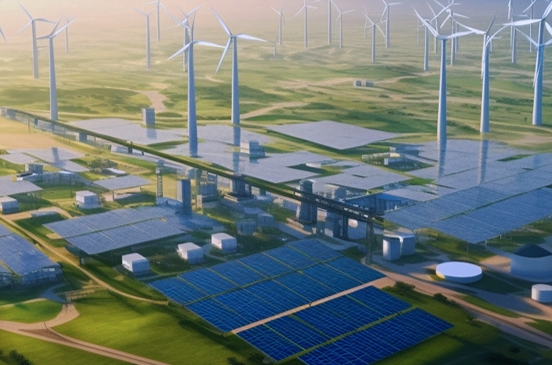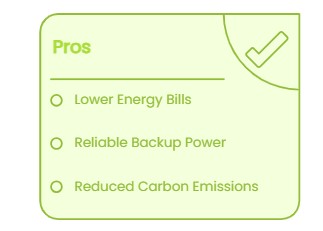
Expert Insights
Solar energy storage is how we save sunlight’s power for when we need it most. The sun provides free, clean energy daily, but it isn't available around the clock. Without storage, solar panels can’t power homes or factories at night or on cloudy days. Storing this energy fixes the problem, converting sunlight into a steady and reliable resource.
Businesses and industries now use solar energy battery storage to save money and reduce pollution. By keeping extra energy made during sunny hours, they rely less on expensive grid power and avoid wasting what they generate. It’s a win for budgets and the planet.
This article explains how solar storage works in simple terms, how it cuts costs, and why more companies are choosing it. Keep reading to learn how solar storage can work for you.

What Is Solar Energy Storage
Solar energy storage is the process of storing excess electricity generated by solar panels for later use. It works by collecting sunlight, transforming it into energy, and storing excess energy in batteries or other systems. This stored energy can then be accessed when sunlight is unavailable, such as at night, during cloudy weather, or when energy demand exceeds what solar panels produce in real time.
The system works simply. Solar panels generate electricity from sunlight, which powers devices immediately. Any unused energy charges the connected storage units, typically lithium-ion batteries. When solar generation drops, stored energy completes or substitutes the grid supply automatically. Smart controllers optimize energy flow, prioritizing solar and stored power to minimize reliance on external utilities.
In short, solar storage turns unreliable sunshine into a steady, clean energy source. It’s why more people are calling it the missing piece of the renewable energy puzzle.
Types of Solar Energy Storage Systems—Categorized by Technology Principle
Solar energy storage solutions vary widely. They are made for different needs. Now, we will look at four common types: battery storage, thermal storage, mechanical storage, and chemical storage. These technologies work in different ways. But they all help make solar power reliable. This works for small homes and also for large industries.
Type | Main Forms | Brief Pros and Cons |
Battery Storage | Lead-acid batteries, lithium batteries, LiFePO4 batteries, etc. | Most widely used, high energy density, suitable for residential and commercial use, limited lifespan |
Thermal Storage | High-temperature molten salt, hot water storage, etc. | Suitable for solar thermal power generation, low cost, limited conversion efficiency |
Mechanical Storage | Pumped hydro storage, compressed air energy storage, flywheel storage, etc. | Suitable for large-scale storage, high efficiency, high investment, large footprint |
Chemical Storage | Hydrogen energy (Power-to-Gas), etc. | Suitable for large-scale, long-duration storage, developing technology, multiple conversion steps |
1. Battery Storage
Battery storage systems save solar energy using rechargeable batteries like lithium-ion or lead-acid. These batteries store electricity chemically, releasing it when needed, such as at night or during cloudy weather. They are optimally used for daily application because of their compact nature and quick response.
Batteries are widely used in homes and businesses. They help people depend less on the power grid and save money on electricity. For example, homes with rooftop solar panels can use battery power at night. Factories install larger battery systems to avoid expensive peak-hour energy rates. Power companies also use big battery installations to help balance the electricity grid.
While battery costs have dropped in recent years, their lifespan depends on usage and type. Lithium-ion technology improves continually, and batteries are a flexible solution for most solar users.
2. Thermal Storage
Thermal storage captures solar energy as heat, storing it in materials like molten salt, water, or rocks. This stored heat can later generate electricity or provide direct heating. Unlike batteries, thermal systems excel at storing energy for days or even months.
Large solar power plants often use molten salt to produce electricity after sunset. Factories might store solar-heated water to run machinery or warm buildings, cutting fossil fuel use. Greenhouses also use thermal storage to maintain stable temperatures for plants.
Though thermal systems take a lot of space and initial investment, their durability and large capacity make them cost-effective for industries with steady energy demands. They're less frequent in small installations but essential in large green energy projects.
3. Mechanical Storage
Mechanical storage converts solar energy into motion or pressure. Examples include pumped hydro (storing water uphill), flywheels (spinning disks), and compressed air systems. These methods release energy by reversing the process—like letting water flow downhill to spin turbines.
Utilities rely on pumped hydro to store excess solar power, while factories use flywheels to bridge short power outages. Compressed air systems help power off-grid solar in remote areas.
Though mechanical systems are highly durable and capable of long-term storage, they depend on specific conditions. Pumped hydro needs hills and reservoirs, and flywheels are best for short bursts of energy. These are some of the most important solutions for grid stabilization as solar becomes increasingly prevalent.
4.Chemical Storage
Chemical storage turns solar energy into fuels like hydrogen or synthetic gas. First, sunlight splits water into hydrogen. Or, it mixes carbon dioxide with water to make clean fuels. These fuels are not like batteries because they can be stored for months and moved easily. This makes them good for industries that need portable or long-lasting energy.
This method is becoming more popular in transportation. For example, hydrogen power trucks and buses. It is also used in aviation, where synthetic fuels replace jet fuel. Heavy industries like steel manufacturing use hydrogen to cut carbon emissions.
But chemical storage has some problems. It is less efficient than storing electricity directly. Also, setting up production and transport systems is difficult. Still, new technology in green hydrogen could help. In the future, it might be key for industries that are hard to power with electricity alone.
Besides these four methods, scientists are developing new ways to store solar energy, like solid-state batteries and gravity storage. These new solutions could make solar power storage cheaper, work better, and be easier to use everywhere in the world.
Benefits of Solar Energy Storage
Solar energy storage isn't just about saving sunlight, it's about changing the way we power our lives. By storing extra solar energy, you can cut costs, increase reliability and reduce your carbon footprint. Let's look at three key benefits.

1. Lower Energy Bills
Storing solar energy lets you rely less on expensive grid electricity. During peak hours when energy prices surge, your stored power can cover household or business needs, cutting monthly costs. Some users in sunny regions even earn money by selling extra energy back to the grid.
Solar storage also locks in long-term savings. Once installed, sunlight remains free, shielding you from rising utility prices and keeping energy budgets predictable.
2. Reliable Backup Power
Solar panels stop working at night or during storms, but stored energy keeps essential devices running. Homes maintain power for lights and refrigerators, while businesses avoid costly downtime during outages.
Some places have unreliable electricity. Solar storage helps them be self-sufficient. Cities also need this. Backup systems stop blackouts when storms come or power systems fail.
3. Reduced Carbon Emissions
Solar storage maximizes the value of renewable energy generation by ensuring no clean power goes to waste. For example, using stored solar power instead of fossil fuels cuts pollution. One home can reduce pollution by 3-4 tons each year. That's like planting 100 trees. (EPA Greenhouse Gas Equivalencies Calculator)
This helps factories reach their green goals and avoid pollution fines. At the same time, neighborhoods get cleaner air and fewer health problems from dirty power plants.
CYG: A Powerful Solar Energy Storage Solution

CYG New Energy Business Group (CYG NEBG), a dedicated division under Changyuan Technology Group (CYG), specializes in energy storage solutions that empower businesses to harness solar power effectively. With decades of experience in industrial energy innovation, CYG NEBG focuses on making renewable energy practical and profitable for commercial users.
Our Core Strengths:
1. Utility-Scale Solar Projects: Develops and manages large solar farms combined with energy storage, offering grids and factories with stable power supply.
2. ndustrial Solar Storage: Creates custom battery systems for factories and warehouses to reduce grid dependency and lower energy costs.
3. Smart Energy Management: Uses advanced monitoring systems, like the PRS-3000, to optimize solar energy storage and usage while tracking performance in real time.
4. Solar-Powered Infrastructure: Connects solar storage to electric vehicle charging stations for round-the-clock clean energy.
5. Full Project Support: Provides end-to-end services from solar system design to carbon footprint analysis, simplifying adoption.
CYG’s solutions help businesses rely less on traditional power sources. Factories, logistics centers, and solar farms trust their systems to meet sustainability goals.

Conclusion
Solar energy storage turns sunlight into a steady power supply, even after sunset. Making solar energy reliable day and night takes more than just sunlight—it takes the right partner. That’s where CYG NEBG comes in, offering practical solutions tailored to industrial needs.
At CYG NEBG, we focus on industrial-scale solar storage solutions. Our energy storage systems for solar power help factories, warehouses, and solar farms save money, rely less on traditional power grids, and meet green energy targets. We handle every step, from designing your system to maintenance, so you can focus on your business.
If your company needs efficient, large-scale solar storage, reach out to CYG. Let us help you build a cleaner, more cost-effective energy future.





